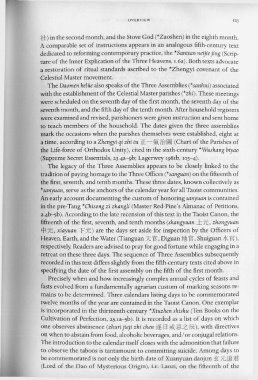Page 163 - The Encyclopedia of Taoism v1_A-L
P. 163
OVERVI EW 12 3
*i) in the second month, and the Stove God (*Zaoshen) in the eighth month.
A comparable set of instructions appears in an analogous fifth-century text
dedicated to reforming contemporary practice, the * Santian neijie jing (Scrip-
ture of the Inner Explication of the Three Heavens, r.6a). Both texts advocate
a restoration of ritual standards ascribed to the *Zhengyi covenant of the
Celestial Master movement.
The Daomen kelii.e also speaks of the Three Assemblies (*sanhui) associated
with the establishment of the Celestial Master parishes (*zhi). These meetings
were scheduled on the. seventh day of the first month, the seventh day of the
seventh month, and the fifth day of the tenth month. After household registers
were examined and revised, parishioners were given instruction and sent home
to teach members of the household. The dates given the three assemblies
mark the occasions when the parishes themselves were established, eight at
a time, according to a Zhengyi qi zhi tu lE - ~ ~ iI (Chart of the Parishes of
the Life-force of Orthodox Unity), cited in the sixth-century *Wushang biyao
(Supreme Secret Essentials, 23.4a-9b; Lagerwey 1981b, 103-4).
The legacy of the Three Assemblies appears to be closely linked to the
tradition of paying homage to the Three Offices (* sanguan) on the fifteenth of
the first, seventh, and tenth months. These three dates, known collectively as
* sanyuan, serve as the anchors of the calendar year for all Taoist communities.
An early account documenting the custom of honoring sanyuan is contained
in the pre-Tang *Chisong zi zhangli (Master Red-Pine's Almanac of Petitions,
2-4b-sb). According to the late recension of this text in the Taoist Canon, the
fifteenth of the first, seventh, and tenth months (shangyuan -.t:lE; , zhongyuan
9=J :lE; , xiayuan "T:lE;) are the days set aside for inspection by the Officers of
Heaven, Earth, and the Water (Tianguan 7( '§ , Diguan ±t!!. '§ , Shuiguan 7l< '§),
respectively. Readers are advised to pray for good fortune while engaging in a
retreat on these three days. The sequence of Three Assemblies subsequently
recorded in this text differs slightly from the fifth-century texts cited above in
specifying the date of the first assembly on the fifth of the first month.
Precisely when and how increasingly complex annual cycles of feasts and
fasts evolved from a fundamentally agrarian custom of marking seasons re-
mains to be determined. Three calendars listing days to be commemorated
twelve months of the year are contained in the Taoist Canon. One exemplar
is incorporated in the thirteenth-century *Xiuzhen shishu (Ten Books on the
Cultivation of Perfection, 2S.Ia- sb). It is recorded as a list of days on which
one observes abstinence (zhuri jieji zhi chen ~ B *,~ZJP(), with directives
on when to abstain from food, alcoholic beverages, and/ or conjugal relations.
The introduction to the calendar itself closes with the admonition that failure
to observe the taboos is tantamount to committing suicide. Among days to
be commemorated is not only the birth date of Xuanyuan daojun K:lE;J1[tt
(Lord of the Dao of Mysterious Origin), i.e. Laozi, on the fifteenth of the

